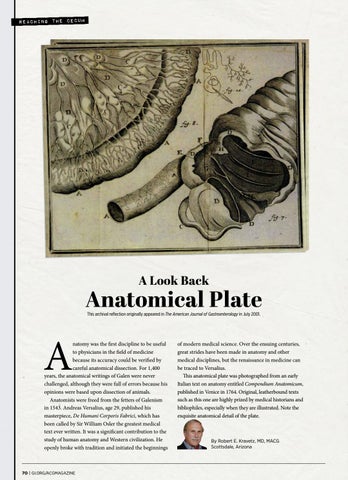M CECUM THE CECU HING THE REACHING REAC
A Look Back
Anatomical Plate This archival reflection originally appeared in The American Journal of Gastroenterology in July 2001.
A
natomy was the first discipline to be useful to physicians in the field of medicine because its accuracy could be verified by careful anatomical dissection. For 1,400 years, the anatomical writings of Galen were never challenged, although they were full of errors because his opinions were based upon dissection of animals. Anatomists were freed from the fetters of Galenism in 1543. Andreas Versalius, age 29, published his masterpiece, De Humani Corporis Fabrici, which has been called by Sir William Osler the greatest medical text ever written. It was a significant contribution to the study of human anatomy and Western civilization. He openly broke with tradition and initiated the beginnings
70 | GI.ORG/ACGMAGAZINE
of modern medical science. Over the ensuing centuries, great strides have been made in anatomy and other medical disciplines, but the renaissance in medicine can be traced to Versalius. This anatomical plate was photographed from an early Italian text on anatomy entitled Compendium Anatomicum, published in Venice in 1764. Original, leatherbound texts such as this one are highly prized by medical historians and bibliophiles, especially when they are illustrated. Note the exquisite anatomical detail of the plate.
By Robert E. Kravetz, MD, MACG Scottsdale, Arizona




